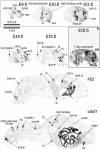Deletion of the gene encoding proprotein convertase 5/6 causes early embryonic lethality in the mouse
- PMID: 16354705
- PMCID: PMC1317638
- DOI: 10.1128/MCB.26.1.354-361.2006
Deletion of the gene encoding proprotein convertase 5/6 causes early embryonic lethality in the mouse
Abstract
PC5 belongs to the proprotein convertase family and activates precursor proteins by cleavage at basic sites during their transit through the secretory pathway and/or at the cell surface. These precursors include prohormones, proreceptors, growth factors, adhesion molecules, and viral glycoproteins. The Pcsk5 gene encodes two alternatively spliced isoforms, the soluble PC5A and transmembrane PC5B. We have carefully analyzed the expression of PC5 in the mouse during development and in adulthood by in situ hybridization, as well as in mouse tissues and various cell lines by quantitative reverse transcription-PCR. The data show that adrenal cortex and intestine are the richest sources of PC5A and PC5B, respectively. To better define the specific physiological roles of PC5, we have generated a mouse Pcsk5(Delta4)-deficient allele missing exon 4 that encodes the catalytic Asp173. While Delta4/+ heterozygotes were healthy and fertile, genotyping of progeny obtained from Delta4/+ interbreeding indicated that Delta4/Delta4 embryos died between embryonic days 4.5 and 7.5. These data demonstrate that Pcsk5 is an essential gene.
Figures






References
-
- Biggers, J. D., L. K. McGinnis, and M. Raffin. 2000. Amino acids and preimplantation development of the mouse in protein-free potassium simplex optimized medium. Biol. Reprod. 63:281-293. - PubMed
-
- Bruneau, B. G., G. Nemer, J. P. Schmitt, F. Charron, L. Robitaille, S. Caron, D. A. Conner, M. Gessler, M. Nemer, C. E. Seidman, and J. G. Seidman. 2001. A murine model of Holt-Oram syndrome defines roles of the T-box transcription factor Tbx5 in cardiogenesis and disease. Cell 106:709-721. - PubMed
-
- Campan, M., M. Yoshizumi, N. G. Seidah, M. E. Lee, C. Bianchi, and E. Haber. 1996. Increased proteolytic processing of protein tyrosine phosphatase mu in confluent vascular endothelial cells: the role of PC5, a member of the subtilisin family. Biochemistry 35:3797-3802. - PubMed
Publication types
MeSH terms
Substances
LinkOut - more resources
Full Text Sources
Other Literature Sources
Molecular Biology Databases
